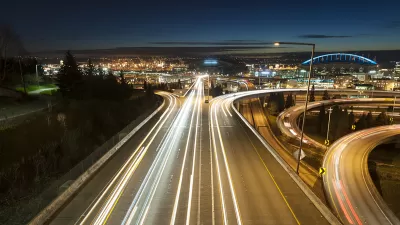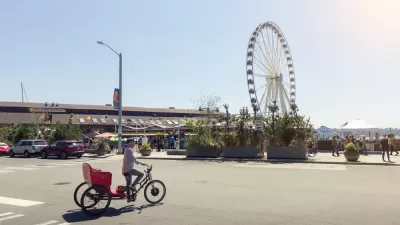With Mayor Jenny Durkan's announcement that Seattle will pursue cordon area congestion pricing coming five days after New York dropped its plan, a Washington State pro-business publication looks at the difficulties in getting the politics right.
Seattle Mayor Jenny Durkan announced on April 4 that her plans to reduce emissions from the transportation sector, responsible for two-thirds of the city's greenhouse gas emissions, would include cordon area congestion pricing, i.e., the tolling of downtown streets. If adopted, it would feature prominently in the Seattle Climate Action plan.
"While some transportation experts see congestion pricing as a viable solution– at least in theory – the success of any plan depends on a combination of implementation and political will," reports TJ Martinell on April 17 for Lens, "a preeminent pro-business, pro-growth online news publication in Washington state."
An [April 2008] Puget Sound Regional Council (PSRC) study [pdf] of a theoretical systemwide congestion pricing produced positive results and could work if implemented, but with the caveat if “done right.”
Angie Schmitt of Streetsblog USA reinforced the point in her blog of April 5 on the Seattle news:
But the politics of congestion pricing are tricky — the new tolls stir opposition, while the benefits aren’t immediately apparent until the policy is in effect — and only a handful of cities have enacted it.
As was shown by the outcome in the New York State legislature on March 30, and surprisingly even among Manhattan assembly members, without political will there is no congestion pricing. Martinell of Lens observes that will be a challenge for Mayor Durkan.
There’s also a lack of political will: a 2015 poll conducted by the Transportation Futures Task Force found over half of Puget Sound voters were either opposed or “strongly opposed” to regional tolling.
Regional or city tolling?
The PSRC study found that tolls on primary roads could easily cause traffic diversion to arterials.
But a Seattle-only toll could just push that traffic to nearby cities, says Washington Policy Center Transportation Director Mariya Frost. She writes that “people, businesses and cars may simply leave, and take emissions elsewhere. This could have a negative impact on Seattle’s economy, despite officials’ assumptions that thousands of drivers will submit and start to take transit.”
However, other experts in transportation, economics, and public policy argue just the opposite.
"Unlike other taxes that can be easily dismissed as imposing costs and killing jobs, congestion pricing improves market efficiencies because it forces people to think about their travel and leads to a more rational use of our public roads," stated John Rennie Short of the School of Public Policy, University of Maryland in February. "In my view, it is a powerful policy whose time has definitely come."
"Around the world, [traffic] is a drag on economic activity and the quality of life," wrote former New York Times economics writer David Leonhardt in January. "People waste hours in it, all the while sending pollution into the air."
A downtown cordon toll, if properly constructed, could prove no different than congestion pricing for downtown parking, making more spaces available for those willing to pay.
Seattle’s tolling interests
Seattle has been here before. The Seattle Variable Tolling Study [pdf] "responds to the [2006] Seattle Climate Action Plan’s direction to investigate variable tolling as a strategy to reduce greenhouse gas emissions," states the executive summary of the 117-page, May 2009 report prepared by Booz Allen Hamilton in conjunction with the City of Seattle Department of Transportation.
The agency should be able to use much of this work, though the technology has obviously advanced considerably. However, the politics have changed even more, and may just motivate the city to go where no other North American city has gone.
"In the time of Trump..."
In her April 4 announcement, the city's commitment to meeting the Paris climate agreement featured prominently. In addition, she told KUOW, Seattle's NPR affiliate:
"In the time of Trump, if local governments, particularly cities, don't lead, we as a country won't meet our climate goals," she said.
==============================
Advice from Stockholm
“Designing an efficient and effective congestion pricing scheme that actually delivers benefits is not easy,” states Stockholm transportation director Jonas Eliasson in an article last November accompanying a Streetfilms video on the Stockholm congestion charge.
Eliasson should know, as he "steered the implementation of congestion pricing in Stockholm in 2006," wrote David Meyer for Streetsblog NYC on Nov. 29.
Before implementation, public support for congestion pricing had fallen below 40 percent. After a six-month trial period in 2006, more than 52 percent of Stockholm residents voted to make it permanent. By 2011, public support for road pricing stood at nearly 70 percent, and above 50 percent even among people who pay the fees most often.
By reducing auto trips, 20 percent in Stockholm's case, congestion pricing not only improves economic activity but public health as well, as Fredrick Kunkle reported for The Washington Post on March 27, 2017.
Researchers at Johns Hopkins University and other institutions who studied Stockholm’s congestion-pricing scheme found that the policy cut air pollution in the city center and reduced childhood asthma cases by nearly 50 percent. The long-term health benefit of congestion-pricing also seemed to become more apparent the longer the policy was in effect.
"To Meet Emissions Goals, Seattle Wants to Charge Drivers," Scientific American, April 6.
FULL STORY: The politics of congestion tolling

Study: Maui’s Plan to Convert Vacation Rentals to Long-Term Housing Could Cause Nearly $1 Billion Economic Loss
The plan would reduce visitor accommodation by 25,% resulting in 1,900 jobs lost.

North Texas Transit Leaders Tout Benefits of TOD for Growing Region
At a summit focused on transit-oriented development, policymakers discussed how North Texas’ expanded light rail system can serve as a tool for economic growth.

Why Should We Subsidize Public Transportation?
Many public transit agencies face financial stress due to rising costs, declining fare revenue, and declining subsidies. Transit advocates must provide a strong business case for increasing public transit funding.

How to Make US Trains Faster
Changes to boarding platforms and a switch to electric trains could improve U.S. passenger rail service without the added cost of high-speed rail.

Columbia’s Revitalized ‘Loop’ Is a Hub for Local Entrepreneurs
A focus on small businesses is helping a commercial corridor in Columbia, Missouri thrive.

Invasive Insect Threatens Minnesota’s Ash Forests
The Emerald Ash Borer is a rapidly spreading invasive pest threatening Minnesota’s ash trees, and homeowners are encouraged to plant diverse replacement species, avoid moving ash firewood, and monitor for signs of infestation.
Urban Design for Planners 1: Software Tools
This six-course series explores essential urban design concepts using open source software and equips planners with the tools they need to participate fully in the urban design process.
Planning for Universal Design
Learn the tools for implementing Universal Design in planning regulations.
City of Santa Clarita
Ascent Environmental
Institute for Housing and Urban Development Studies (IHS)
City of Grandview
Harvard GSD Executive Education
Toledo-Lucas County Plan Commissions
Salt Lake City
NYU Wagner Graduate School of Public Service





























